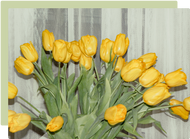Posted by by the Gubba Team
8th Mar 2023
Planting spring-flowering bulbs in NZ

Autumn means it’s time to get those spring-flowering bulbs in the ground! We’re already anticipating those beautiful spring & summer blooms. If you’re new to bulb growing, or still wondering what to plant this year, read on for some bulb planting tips & inspiration.

Which bulbs should I choose?
There are plenty of spring flowering bulbs to choose from; here are some popular varieties grown here in NZ:
Crocus [early bloom]
This hardy flower does well in colder regions, but can be grown successfully all across the country. Crocus are early bloomers, providing some welcome colour from late winter to early spring. Plant them somewhere with full sun if possible (although they will also tolerate partial shade), and ensure they are in an area with well-draining soil. These bulbs multiply quickly, meaning you’ll have more and more each year.

Ranunculus [mid bloom]
Technically a corm (not a bulb), this colourful flower can be planted from as early as mid-January, all the way until mid-May. Planting early will result in flowers from mid to late winter, while planting later will produce flowers from mid spring. Plant them in either full sun or partial shade, and ensure soil is well-draining. Ranunculus will also grow well in pots or containers.
Tulip [early bloom]
Possibly one of the most well-known & loved spring bulbs, these bright, colourful flowers are a welcome sight when they bloom in spring. They are quite a hardy plant and can be grown across NZ; however, if you live in a warmer region you’ll need to “chill” your tulip bulbs in the fridge for 6-8 weeks before planting. Place them in the fridge around late March, ready for planting in late May. They can be grown in either full sun or partial shade, and like good well-draining soil.

Bluebell (Scilla) [late bloom]
The two most common bluebell varieties are English Bluebells and Spanish Bluebells. Here in NZ, our climate is more suited to Spanish Bluebells - hence this is the most common variety you’ll see around. These are one of the easiest bulbs to grow, and will multiply quite quickly once you get them started. Plant in autumn to enjoy flowers throughout spring & summer. Bluebells like partial shade, making them great flowers to position beneath trees.
Daffodil [early - mid bloom]
This iconic yellow flower provides some welcome spring cheer! You can’t go too wrong with daffodils; plant these easy bulbs between mid-March and late May to enjoy flowers throughout spring. Daffodils like full to partial sun, and need good well-draining soil. They’ll also grow happily in containers or pots. There are so many varieties to choose from these days when it comes to both colour and bloom time, making them a great choice when considering succession planting!
Hyacinth [mid bloom]
This lovely bloom is known for its sweet, fragrant scent. This is a bulb that needs a decent period of cold to bloom properly - if you live in an area with warmer winters, you will need to chill hyacinth bulbs in the fridge for about 6 weeks prior to planting. Plant your hyacinth bulbs from early March right through to the end of May for spring blooms. Choose a well-draining spot in full sun. Remember to wear gloves when handling hyacinth bulbs! They are toxic and could cause irritation to the skin.
 Chilling your bulbs
Chilling your bulbs
Most spring-flowering bulbs need consistent cool temperatures (below 10°C during the day) in order to produce a flower bud. This period of dormancy over winter is essential for them to complete their development. Come spring-time, rising temperatures signal to the plant that it’s time to bloom! This means in areas with warmer winters (most of the North Island here in NZ), certain bulbs will need a bit of help; particularly bulbs that are native to cooler regions such as hyacinths and tulips. You can do this by popping them in the fridge for a period of time before planting - what gardeners call “pre-chilling” their bulbs.
The length of time you need to chill each type of bulb will vary, but usually around 8 weeks is sufficient. If you live in an area that doesn’t see many frosts, you should pre-chill your Daffodil, Tulip, Crocus and Hyacinth bulbs.
If your bulbs don’t have a sufficient chilling period (whether that be naturally in the ground over winter, or in the fridge before planting), you’re likely to see plants with stunted growth and small flowers.
Some pre-chilling tips to keep in mind…
- Keep your bulbs in the crisper drawer inside a paper bag (NOT plastic - the bulbs will sweat, causing rot).
- Do not place them near the back of the fridge as it may be too cold.
- Keep them well away from fruit, particularly apples and pears. These fruits emit a gas called ethylene as they ripen which can damage your bulbs.
 Planting your bulbs
Planting your bulbs
Ideal planting depth depends on the type of bulb. The packaging your bulbs come in should provide specific details. However, you can use this general rule of thumb: plant the bulb 2-3 times the height of the bulb. For example, if your bulb is 2cm tall you should plant it about 4-6cm deep. And if in doubt, too deep is generally better than too shallow!
It’s also important to plant your bulbs the right way up - with the pointed end facing upwards towards the sky. You’ll be able to identify the pointed end easily with ‘true’ bulbs such as daffodils and tulips, however it can be a bit harder with bulbs such as ranunculus or anemone. Plant these bulbs on their sides - they’ll grow towards the light and straighten out themselves.
Prepare your soil for planting by loosening it up and mixing in some bulb food (such as the Tui Bulb Food) and compost. Spring-flowering bulbs like well-draining, loamy soils. When planting, you can use a bulb planter to save time and avoid bending - a game changer when you’re planting out lots! We recommend the Sneeboer Stainless Bulb Planter or Sneeboer Great Dixter Bulb Planter.
Feed with bulb food again when stems start appearing, and then again when flowering starts.

Succession & Stagger Planting
To enjoy continuous flowering throughout spring and summer, make sure you’re planting an assortment of bulbs: you want your garden to be made up of early blooms, mid blooms and late blooms. Succession planting is essentially choosing bulbs that bloom at different times. The packaging of your bulbs should give you the relevant details for the specific variety you have. Don’t forget to take bloom time & height into consideration when planning your garden, too! You can get really creative - with some pre-planning, you’ll enjoy a colourful garden all season long.
Stagger planting is another way to enjoy your flowers for longer. Simply plant your bulbs (of the same variety) in groupings two weeks apart, for a period of 6-8 weeks. This way your bulbs should bloom at staggered times throughout the season.


























